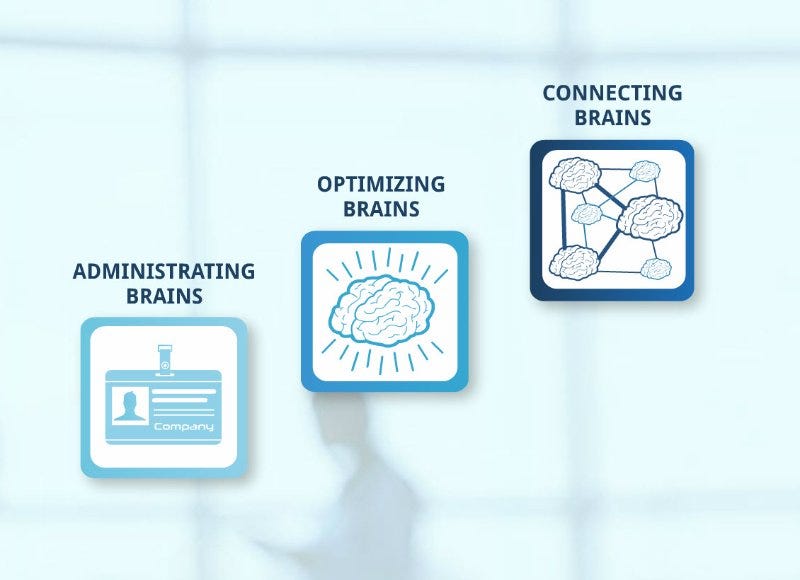How HR Can Drive Innovation for Customer Satisfaction
 What is the purpose of Human Resource Management?
What is the purpose of Human Resource Management?
Is it to administrate brains, send them letters and pay them?
Or is it to connect brains, drive innovation and delight customers?
The answer is both.
The real question is: Why are so many HR departments stuck in operations and close to useless as enablers of change? Time to wake up. It’s 2016. Let’s embrace the possibilities of technology to make HR a profit center. Make HR the soulful heart that pulsates the organization forward.
From the past to today’s reality
The only reason for this passive inert behavior of HR is because they have always done it like that. Following legislation and making sure that people are administrated and paid correctly. For hundreds of years HR was about administrating brains. And that is deep in their DNA.
In was in the beginning of this century that HRM was relabeled to HCM; Human Capital Management. We discovered that a company’s most valuable asset weights 1.5 kilogram; the human brain. We began to focus on the right person on the right job on the right time. We were optimizing brains; Talent Management.
And while many organization still struggle with talent management, we are already in another era. Social, mobile, cloud and big data are omnipresent. Consumers know all there is to know about products and services on their mobile devices with social opinions from the entire world. Hyper connectivity. But only a fraction of organizations are able to hyper connect their own employees in order to create better products, services and customer experiences! The few that do, are changing industries. They disrupt. They are connecting brainpower.

The impact on customer satisfaction
What is the impact these three Human Resources phases on customer satisfaction?
Administrating Brains does not have any impact on customer satisfaction. Of course you have to pay people, otherwise they leave. Improving the administration of brains is done by continuously reducing (administrative) time and money spent by employees, managers, HR and IT. Usually via automation. And thus, the benefit of administrating brains is ‘only’ about lowering cost.
The moment you start to administrate and optimize brains, is the moment HR comes to life and has an impact on people engagement and business execution. The benefit is then lowering cost and increasing revenue.
But that’s not enough to survive in this highly competitive marketplace because only connected brains can tap into unmet customer needs and generate innovation needed to stay ahead of the curve. Administrating, Optimizing and Connecting brains all together has the biggest benefits:lowering cost, increasing productivity and — most important — driving innovation!

Let’s put this to the test
Visualize your best/ideal employee.
Now visualize your HR department only administrating his/her pay scale, working hours, expenses and contract. How does that help your company to perform better?
Now visualize the same super employee placed on best suitable job in the company. Imagine you can scale up with more of your employees being put on the right places, getting them engaged and using their full potential. Wow, that is adding value right?
By the way… Who is determining who is talented in the company?
Right. It’s usually a manager and/or an HR employee.
Now imagine it’s no longer one or two people who determine who’s talented. It’s the community that determines who is talented. Then the entire organization knows who’s talented because that is transparent. Your customers know it too. And imagine what will happen if those talented people are continuously connected, generating idea on idea, being engaged by it and driving your proposition of tomorrow. Now that has not only an impact on revenue generation today, but on customer satisfaction! And thus on revenue generation tomorrow.
What does the future hold for Human Resources?
Companies like SAP are automating core HR, like robots are taking over repetitive work at a conveyor belt. But one thing will not be automated so quickly: the creativity of people. It is humans that innovate and thus it’s the Human Resources department that has the unique potential to transform the business. I predict that in the near future, the administration of HR is close to being completely automated. And then there is only one role for HR that remains: improving productivity and driving innovation!
Conclusion
It’s time for many HR folks to ask the why question. I don’t see a prosperous future for employment in the administrative side of HR. It’s time for HR as a profit center. Full stop. Human Resources as a key differentiator in empowering, engaging and connecting the community. Making sure there are platforms in place and guidance to optimize communication, creativity, and innovation.
Wait! Before you go…
Choose how you want the latest innovation content delivered to you:
- Daily — RSS Feed — Email — Twitter — Facebook — Linkedin Today
- Weekly — Email Newsletter — Free Magazine — Linkedin Group
 Patrick Willer is a Workforce Innovation Consultant at SAP. He is intrigued by people: How we think, connect, and create together. This is what inspires his learning, and informs his business career in Human Capital Management. Patrick specializes in creativity, innovation, social collaboration, and solution-focused planning and execution of strategies impactful to Human Capital Management. Follow or connect with Patrick @PattWiller
Patrick Willer is a Workforce Innovation Consultant at SAP. He is intrigued by people: How we think, connect, and create together. This is what inspires his learning, and informs his business career in Human Capital Management. Patrick specializes in creativity, innovation, social collaboration, and solution-focused planning and execution of strategies impactful to Human Capital Management. Follow or connect with Patrick @PattWiller
NEVER MISS ANOTHER NEWSLETTER!
LATEST BLOGS
Three things you didn’t know about credit cards
Photo by Ales Nesetril on Unsplash Many of us use credit cards regularly. From using them for everyday purchases to…
Read MoreFive CV skills of a business-minded individual
Photo by Scott Graham on Unsplash The skills listed on a CV help employers quickly understand your suitability for a…
Read More


